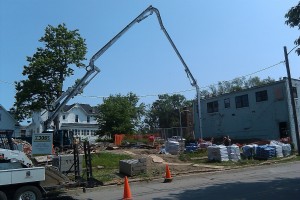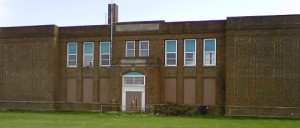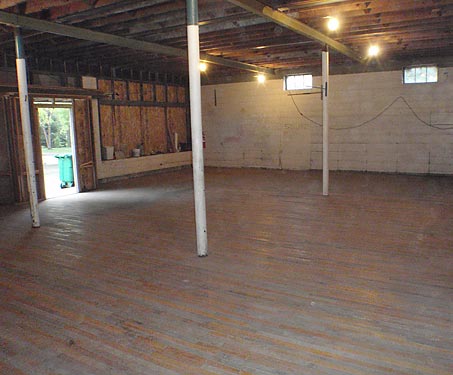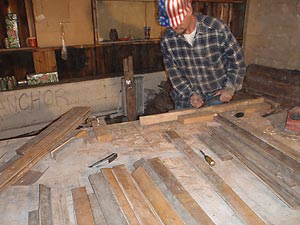
A very rainy June day in Iowa.
The Weather at Green & Main
It just could not stop raining in June. We’re not talking the standard ½-inch flush that cleans city streets while households sleep, leaving the air smelling fresh in the morning. No, we’re boasting serious downpours that dump upwards of five inches of rain in twenty-four hour cycles and repeatedly interrupt our planned work days, while also putting officials and drivers on the alert for early morning street closings.
Mother Nature has been busy exceeding all sorts of records, and construction crews have been busy in their accommodation. This has held true at the pilot project building. One can only laugh, perhaps, at the construction delays caused by an overload of rainwater, given that one of our project’s main assertive goals is to provide this property with maximum stormwater management and release.
Much to be Done
Before we reclaim the site, amending the soil and establishing bio-systems to capture storm water and to encourage infiltration, the addition must be completed. This includes tuck-pointing and waterproofing the subterranean concrete block walls of the existing building. Protecting the building’s foundation from bulk water intrusion and sub-surface water pressure helps to establish an effective basis for high-performance rehabilitation of the structure. This is not such an easy task when the over-dig for the basement serves to generate a moat regularly, thereby limiting access to the work zone.
The geo-technical soil analysis did prepare us for slow infiltration of water into layers of Wisconsin Clay, but not during construction, nor nine feet below grade. While we have taken precautions to control erosion from the site, no plans account for the impact recurrent downpours have on the productivity of construction. So each morning, submersible pumps would dispel the growing brown pool of water through multi-colored hoses, generating enough white noise to dampen the sound of the nearby interstate. The process was something to watch. The continuous ingenuity exhibited by Jason Anderson, Silent Rivers’ site-supervisor, and the craftsmen from Atlas Masonry, never ceased to amaze me. Each morning they restored temporary tents to protect the fresh mortar, using concrete blocks and pallets to work above the flooded muck as the pumps churned below.
Inside the foundation walls we encountered additional challenges: unanticipated water pooling within the basement. The building’s lower level lacked capacity to shed rain water, functioning as a wading pool without a drain – never mind that the recently poured basement floor includes eight drains that exist to receive heat pump condensate and protect the lower level in the event of equipment or plumbing failure. During the finishing of the cement floor, temporary drain caps were removed by tradesmen and one drain, located within the addition, opens to the sky. Typically, such a detail wouldn’t cause issue, as the drains would connect and discharge into the municipal system. Of course, not in our case!
The city’s sewer remains cracked, disallowing the project to connect to public works until repairs are made – we discovered this dilemma in late spring. So with pending grant deadlines and increasing financial pressures, construction pressed on. The conditions: the six-inch access pipe terminates just beyond the southeast corner of the building. Stubbed-out and capped, the pipe awaits connection to public works. In the meanwhile, the building lacks capacity to drain. The result: eight unexpected puddles in the basement. However, a quick response with a late-night remedy was in the works. Jason Anderson, knowing the drains were not in working order, made a 10 p.m. trip to the job site. He located another pump to remove the water and capped the exterior drain opening to limit access to the network of pipes below.
Weather and Design
From the initial deluge during our groundbreaking ceremony to this recent inundation of storms, we are constantly reminded of the power of nature, and the imperative to design in balance and harmony with natural resources and cycles. Water is an essential resource, not only to the existence of our species, but as a dynamic impact on our shelter and its surroundings. Considering that most every design decision made for the Green & Main Pilot Project evaluates the influence of water on the building and its performance – while reciprocally weighing the impact the building, the site and its use has on this most precious resource – these reminders are quite apropos. They help encourage and reinforce a stewardship ethic that is central to our initiative.
– Chaden Halfhill is an entrepreneur and visionary of the Green & Main Initiative. He likes to reclaim and repurpose, then go out for lunch.
]]>

Charles Durrett
Charles Durrett, an award-winning architect and leader in the North American cohousing movement, will present an overview of the cohousing concept of building community at 7:00 pm on Thursday, July 14 in Des Moines, IA at the Windsor Heights Community Center. The presentation is open to the public and is located at 6900 School Street, next to Colby Park (69th Street south of University Avenue). It will be of particular interest to community builders, neighborhood associations, architects, green builders, city planners and community-conscious people who want to create better neighborhoods. This presentation is sponsored by Turtle Farm Cohousing Community, Indigo Dawn, Silent Rivers and RDG Planning & Design.
In addition to gaining general knowledge of cohousing, attendees will learn about a current local initiative to build such a community. Those interested in being part of this initiative, the Turtle Farm Cohousing Community, will be invited to view the property at an upcoming open house.
What is Cohousing?
Cohousing is “intentionally building community.” Cohousing neighborhoods are composed of privately owned homes clustered around shared open space and common facilities. The common house is the heart of the community, designed for events such as group dinners, children’s play, fireplace gatherings, guest lodging, gardening, and yoga. Cars are kept to the exterior of the site, making the neighborhood pedestrian-friendly and safe for children. The future residents are involved in the design so that it reflects their needs and priorities. Environmental sustainability is a core value in cohousing projects.
What is Turtle Farm Cohousing Community (TFCC)?
Turtle Farm is a 20-acre, privately owned, certified organic fruit and vegetable farm in Granger, Iowa. Owner Angela Tedesco has been operating this farm as Community Supported Agriculture (CSA) for the past 13 years. Others have joined her in forming TFCC, LLC to support this cohousing project.
The Turtle Farm Cohousing Community envisions a new model for urban agriculture that places cohousing on the non-farmed portions of the land. The community owns the farm in common, so that it can continue to exist as a farm to feed the community, or to remain as an income-generating resource, serving residents of central Iowa.
About Charles Durrett
An architect by training, Charles Durret brought the idea of cohousing to the United States about twenty-five years ago from Denmark. While living there and attending the Royal Academy of Art and Architecture, Durrett and his wife Kathryn McCamant were intrigued by distinctively friendly, inviting, active neighborhoods called “living communities” and began studying them. McCamant & Durrett Architects have since designed and consulted in 50 cohousing communities. Now there are 120 cohousing neighborhoods in the US and Canada and almost 100 more in some stage of development. They are the authors of the recently released bookCreating Cohousing: Building Sustainable Communities (third edition). Durrett also wrote Senior Cohousing: A Community Approach to Independent Living—The Handbook (now in its second edition). Find out more at www.cohousingco.com.
About Indigo Dawn
Indigo Dawn, LLC is a development company that generates progressive community-wide solutions, promoting and encouraging sustainable lifestyles. Indigo Dawn collaborators include: historic rehabilitation experts, business strategists, sustainability educators, communication specialists and event managers. Our mission: to create sustainable communities and to teach others how. Indigo Dawn – Developing a New Way, 735 19th Street, Ste 2, Des Moines, IA 50314
About Silent Rivers Design + Build
Silent Rivers, Inc is a design and construction firm that specializes in authentic well-managed residential solutions. Over 18 years strong, Silent Rivers has received national awards for best practices in design, renovation and business stewardship. Building Inspiration – Bringing People Home, offices located at 9205 Swanson Blvd, Clive, IA 50325
RDG Planning & Design. RDG designs spaces that fit the way people live, work, play and learn. Our core values are building relationships on respect and trust; bringing passion, energy and creativity to every project; leading the way with technology and sustainability; and being actively involved in the communities we serve. We’re architects, landscape architects, engineers, artists and planners with a passion for design and a drive to make a difference.
– Tizzy Hyatt is a grant writer and event planner for Indigo Dawn. She does not appreciate long Monday meetings.
]]>
Installation of the basement concrete floor using a concrete boom truck.
On a Monday in early June, while the heat index was slated to reach 114 degrees, the concrete basement in the Green & Main building at 800 19th Street was poured by Rick Hogan Construction. The construction team brought in the concrete boom truck and positioned it to allow best access to the basement.
Extra challenges encountered were not due solely to the heat, but to pouring a basement inside an already existing building – which created a couple of logistic challenges – but nothing that long pipes and hoses could not address.
The layers of the basement floor are very specific. First, there is earth. Next comes 6 inches of 1 inch river rock followed by 2 inches of styrofoam. On top of the styrofoam is a layer of polystyrene which is followed by another inch of styrofoam. The icing on the basement cake is 5 inches of concrete. This concrete mixture is composed of crushed glass, fly ash and slag – all recycled products. Finally, there is a bentonite strip that is placed around the internal edges where the floor meets the wall to help with waterproofing.
One additional component to the concrete mixture is microfiber. Microfiber helps to reduce shrinkage cracks, and in the heat of an Iowa summer, helps to slow the process of drying when the high noon sun is beating down on the freshly laid concrete.
An interesting side note is that Rick Hogan, who owns the company, worked for a Pepsi distributor when he was 18, having grown up on the west side of Des Moines. He made multiple deliveries to this building when it was H&H Grocery, getting to know the owner a little bit. As time and choice would have it, Rick returned to this site, contributing to its ongoing historical narrative through his construction contributions.
For additional photos of the basement concrete flooring process, please see our photo gallery.
– Jean Danielson is director of operations for Indigo Dawn. She believes in a free lunch and the tooth fairy.
]]>
The old school in Cambria, Iowa needed a new floor at the same time Green & Main was looking for salvage flooring. Repurposing the old maple floor was a perfect fit for the main floor — and sustainability goals — of our Pilot Project.
The original maple hardwood flooring in the Green & Main Pilot Project building provided solid footing for many, many years, probably since the 1930’s when the building housed Sherman Hill’s H&H Grocery Store.
“We could actually see how the store was used by how the floor was worn,” remarked Chaden Halfhill, developer of the Green & Main initiative. Most noticeable was a small area of the wood worn down to only 1/8” thick by the shopkeeper himself who stood in one part of the floor serving customers for years.
Preserving as much of the original floor as possible was of paramount importance to the Green & Main team. However, wear and tear and some exposure to the elements had taken its toll on the solid maple flooring. So a process of painstakingly cleaning the tongue and groove maple flooring began. The Green & Main construction crew carefully pulled up individual slats of the maple flooring, evaluated each piece to ensure that it could be salvaged, and cleaned and replaced the slat back into the floor.
However not all the maple slats were in good enough shape to preserve. So, the Green & Main team set out to find matching maple flooring to fill in the areas of the floor that couldn’t be saved.
Flooring from Cambria, Iowa in Wayne County
Around the same time maple flooring matches needed to be found, Mike Kinter of Des Moines’ Kinter Construction had discovered that a public school in Cambria, Iowa was hoping to replace the gym’s original wood floor. The southern Iowa community in Wayne County was converting the school, which closed in 1991, into a community center. The old gym floor was for sale, and it was hardwood maple. A perfect match!
“I drove down to Cambria and found the flooring in good shape,” said Kinter. “Most hardwood flooring in older school gyms is subjected to many layers of varnish over the years. Given how old the Cambria school gym was, it was amazing to find this flooring with just one or two layers of varnish which takes much less time to remove. So much of it was salvageable, it took me two truckloads to bring it all up to Des Moines.”
Through the grapevine, Mike heard that the Green & Main building was in need of supplemental maple flooring. The width of the maple flooring from Cambria’s old gym was a perfect fit. The needed pieces were identified, cleaned and integrated into the existing flooring. Now a beautiful ‘new’ maple hardwood floor is ready to support the many people who will step foot into the Green & Main building’s education space in the coming decades.
“It turned out that re-using the Cambria gym floor was a good solution for everyone,” concluded Halfhill. “We’re estimating that 70% of the new floor ended up coming from the Cambria maple. And, the purchase price for the old maple gym floor will go to completing construction of the Cambria Community Center. Any wood flooring that we determined to be too damaged to be used in the Pilot Project will be recycled.”
That’s a win-win-win!

A shot of the Green & Main Pilot Project main floor shortly after the maple flooring from the Cambria school was installed. It’s now ready for finishing and many more years of traffic as the flooring for this building’s education space.
– Ann Wilde is a Des Moines marketing strategist and writer who also has a special interest in preserving and creating sustainable communities. She likes traveling to places that have amazing technological gadgets.
]]>

Sustainable brick patio in a suburban backyard.
The other day I was helping the teenage son of a friend pick weeds out of the backyard brick patio. I took that moment to tell Owen about stormwater management and how, even though we live in a built environment, we are not separate from the world around us. We are responsible for managing and engineering ways that are compatible at the very least – and assistive at the very best – in creating a sustainable way to exist and thrive in tandem with one another.
After talking about this briefly, and hearing pauses and seeing head tilts, I put it in language I knew he would understand. “It is about urban engineering,” I said, as I knew he created worlds in his computer games and understood causality well. “Instead of having a slab of concrete that moves the water to places around the base of the house that could impact the structure, the cracks between the bricks help the water soak into the ground where it lands, instead of moving it en masse to places where it could do damage.”
He nodded and we returned to our weed picking.
For many days I have been thinking about sustainability and memory, historical preservation and remembrance. The built environment provides us with a different type of memory. It is a perpetual ‘memorial’ to what went before us. As memorials too often reference something or someone that no longer exists, I was struggling to figure out ways to re-imagine how individual and collective memories are made solid around us and how to talk about this. In doing so, I was immediately reminded of the Main Streets Conference in Des Moines last week, put on by the National Trust for Historical Preservation in Washington D.C.
An untold number of volunteers have gotten together through the Main Streets program to create dynamic and sustainable forms of community living that repurpose buildings so they may be used in current, economically viable ways that provide a solid footing for not just a few years down the line, but 20 years, 50 years and beyond.
These volunteers and managers understand that their present will be the past of those who are yet in pre-school or junior high. Once these young ones reach adulthood and have families and work in their home communities, it will be a present that they, too, seek to enrich by shared community histories and experiences.
Buildings are part of the language of memory. The structures of our main-street, urban and rural communities are tangible narratives of the best ideas and worst ideas of who we are. The Green & Main Pilot Project seeks to take the best of a particular piece of history in the Sherman Hill neighborhood and re-envision it. We are doing this through extensive dialog with preservationists and just as extensive dialog with sustainability experts at the intersection of building science and green technology.
As my mother said to me the last time she hugged me before we parted, “I am creating memories.” This is what the Green & Main team is doing as well – though we are still in the throes of creation.
– Jean Danielson is director of operations for Indigo Dawn. She believes that lemonade is best served with sunshine.
]]>
Chaden Halfhill speaking with Tim Reinders, Design Consultant with Main Street Iowa.
The National Main Streets Conference
The National Main Streets Conference opened earlier this week in Des Moines. Events ranged from tours to evening outings while the central meet-up point was the Polk County Convention Center where 1,300 people convened over a four-day period.
Sunday offered a free session on the Main Street Four Point Approach, created through the National Trust for Historic Preservation in Washington D.C. The Four Point Approach is characterized by Design, Organization, Promotion and Economic Restructuring. It is a very specific template to follow in order to be considered a Main Street Community through the National Trust’s program.
A pilot project began in 1977 through the Chicago office. Three communities throughout the Midwest were chosen and the Trust pledged to work with them for three years to assist with strategies that identified assets and impediments to ultimately leverage the good stuff for downtown economic revitalization. A book grew out of this experience and currently 40 U.S. states have active Main Street programs and communities, the direct outcome of which is new business, physical improvements and community vitality.

Banners representing Iowa’s 45 Main Street communities as displayed at the National Main Streets Conference.
What is a Main Street Community?
So what is a Main Street Community? As over a hundred of us sat in a large conference room, we learned it is a shared vision with a tremendous amount of work. The outcomes, however, are incredible and far reaching. There are 45 active Main Street Communities in Iowa, including Woodbine, Spencer, West Union, Marshalltown, Ames, West Branch, Central City, Burlington, Osceola, Iowa Falls, West Des Moines and the 6th Street Corridor in Des Moines.
In 1985 the Iowa Legislature adopted the program and placed it within the purview of the Iowa Department of Economic Development in order to
…improve the social and economic well-being of Iowa’s communities by assisting selected communities to capitalize on the unique identity, assets and character of their historic commercial district. Main Street is economic development within the context of historic preservation.
The National Main Street Community Criteria that is followed are ten-fold:
1. Have broad-based public and private support
2. Vision and mission statements
3. Comprehensive work plan
4. Historic preservation ethic
5. Active board and committees
6. Adequate operating budget
7. Paid, professional program director
8. On-going training for staff and volunteers
9. Reporting of key statistics
10. Current member of National Main Street Network
Volunteers & Community
The formula is comprehensive and community-driven. It seeks to flesh out and leverage traditions and expertise of a town or region meeting needs for economic stability, growth and solid expectations about a vital future.
There are an untold number of volunteers around the state who see that their future will one day be somebody’s present. These are motivated people who want their extensive efforts for the cultural and economic revitalization of their communities to be a solid footing on which many others can learn, grow, contribute and thrive.
– Jean Danielson is director of operations for Indigo Dawn. She likes sidewalks and walking down them while window shopping. And then buying things.
]]>





